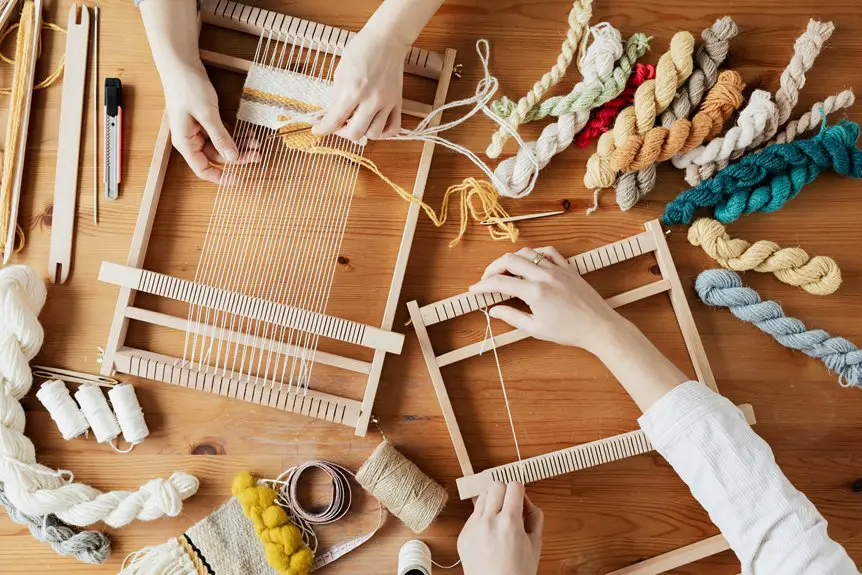When you want to understand how khadi fabric is made, start with sourcing and preparing soft, clean cotton fibers. You then spin these fibers into yarn using a traditional charkha for strength and texture. After dyeing the yarn naturally, you design a unique weaving pattern inspired by culture and nature. The handloom brings it all together as artisans skillfully weave the fabric by hand. Inspecting and finishing guarantee quality. Keep exploring to discover the rich heritage and eco-friendly benefits woven into khadi.
Table of Contents
Key Takeaways
- Cotton fibers are cleaned, aligned, and prepared for spinning to ensure khadi’s softness and strength.
- Artisans spin cotton fibers into yarn using a traditional charkha, maintaining tension for strong, even threads.
- Yarn is dyed naturally with eco-friendly sources like indigo and turmeric to create vibrant, sustainable colors.
- Weaving patterns inspired by nature and culture guide artisans in hand-weaving fabric on traditional looms.
- Finished cloth is inspected, washed gently, trimmed, and sun-dried to enhance texture and durability.
Sourcing and Preparing Cotton Fibers
The journey of khadi fabric begins with sourcing high-quality cotton fibers, which you’ll find are vital for its unique texture and strength. You’ll want to select cotton that’s clean, soft, and free from impurities to guarantee the final fabric feels comfortable and durable.
Once you have the raw cotton, you’ll separate the fibers from seeds and debris through a process called ginning. This step is essential because leftover seeds or dirt can weaken the fabric or cause uneven weaving.
After ginning, you’ll gently fluff and align the fibers to prepare them for spinning. This careful preparation preserves the cotton’s natural qualities, setting the foundation for the hand-spun yarn that gives khadi its distinctive character.
Spinning Cotton Into Yarn
You’ll twist the prepared cotton fibers into yarn using a traditional spinning wheel called a charkha. As you guide the fibers onto the spindle, you’ll carefully control the tension, ensuring the yarn is strong and even.
The rhythmic turning of the charkha allows you to draw out the fibers, twisting them tightly to form continuous strands. This manual process demands patience and skill, as inconsistent spinning can weaken the yarn or cause breakage.
Setting Up the Handloom
Prepare your handloom by carefully arranging the warp threads, which form the fabric’s foundation.
Begin by stretching these threads evenly across the loom’s frame, ensuring consistent tension to avoid uneven weaving. Secure each thread tightly to prevent slack that could distort the fabric’s pattern.
Next, thread the warp through the heddles—small loops or eyelets that help lift specific threads during weaving. This step determines the weave’s design and density.
Then, pass the warp threads through the reed, which spaces them uniformly.
Finally, wind the warp onto the warp beam, maintaining steady tension throughout.
Dyeing the Yarn Naturally
When you dye Khadi yarn naturally, you use traditional sources like turmeric, indigo, and madder roots.
These eco-friendly methods not only bring vibrant colors but also protect the environment.
You’ll see how this process respects nature while adding unique shades to the fabric.
Traditional Dye Sources
Although synthetic dyes are common today, traditional dye sources remain essential for achieving the authentic, natural colors that define khadi fabric.
When you use these time-honored materials, you connect directly with centuries of craftsmanship.
Here are three key traditional dye sources you’ll often encounter:
- Indigo – Derived from the indigo plant, it produces deep, rich blues that are vibrant yet earthy.
- Madder Root – This yields warm red and orange hues, offering a natural warmth to the fabric.
- Turmeric – Known for its bright yellow tones, turmeric adds a fresh, sunny color with natural antibacterial properties.
Eco-Friendly Dyeing Methods
Since eco-friendly dyeing methods prioritize sustainability, they focus on using natural ingredients and minimizing waste throughout the process. You’ll often work with plant-based dyes extracted from flowers, leaves, roots, and bark, which are biodegradable and free from harmful chemicals. This approach preserves the environment and enhances the fabric’s natural appeal. You’ll also reuse water during dyeing and avoid synthetic fixatives.
Here’s a quick look at common eco-friendly dyes:
| Natural Dye Source | Color Produced | Plant Part Used |
|---|---|---|
| Indigo | Deep Blue | Leaves |
| Turmeric | Bright Yellow | Root |
| Madder | Red | Root |
| Pomegranate | Yellow-Green | Rind |
Designing the Weaving Pattern
Now that the yarn is dyed, you’ll start designing the weaving pattern by finding inspiration from nature, culture, or traditional motifs.
You’ll carefully select thread colors that complement each other and bring your vision to life.
Finally, you’ll draft the weaving design to guide the loom in creating the fabric’s unique texture and look.
Pattern Inspiration Sources
When you design a weaving pattern for Khadi fabric, you draw inspiration from a rich blend of nature, culture, and tradition. This process connects you to the roots of the craft, making each pattern meaningful.
Consider these primary sources for your designs:
- Natural Elements: Leaves, flowers, and geometric shapes found in the environment inspire organic and balanced motifs.
- Cultural Symbols: Traditional icons and regional art forms reflect heritage and add storytelling depth.
- Historical Patterns: Classic Khadi and tribal weaves guide you in preserving authenticity while allowing creative expression.
Selecting Thread Colors
Drawing inspiration from nature and tradition sets the stage for selecting thread colors that bring your Khadi weaving pattern to life.
You’ll want to choose hues that reflect the cultural essence and natural environment inspiring your design. Consider earthy tones like ochre, rust, and deep greens, which evoke the raw beauty of Khadi’s roots.
Also, think about contrast and harmony; pairing vibrant threads with muted shades can highlight intricate details in your fabric.
Keep in mind the availability of natural dyes, as they influence color vibrancy and longevity.
Drafting Weaving Designs
Although selecting thread colors sets the mood, drafting your weaving design brings your Khadi fabric to life. This step transforms simple threads into intricate patterns that tell a story.
You start by sketching your design, considering symmetry and balance. Next, you map out the pattern on graph paper or digitally, aligning it with the loom’s capabilities. Finally, you finalize the draft, making certain it’s clear for the weaver to follow.
When drafting your weaving design, focus on these key aspects:
- Pattern Complexity – Decide if you want simple stripes or elaborate motifs.
- Thread Interaction – Plan how colors and textures will intersect.
- Functionality – Confirm the design suits the fabric’s intended use.
This thoughtful approach turns your vision into authentic Khadi art.
Weaving the Fabric by Hand
As you begin weaving khadi fabric by hand, you’ll notice how each thread is carefully interlaced on a traditional loom. You control the shuttle, passing the weft thread over and under the warp threads rhythmically. This process requires patience and precision to maintain even tension and create a uniform texture. The handloom’s wooden frame supports the warp threads, allowing you to create intricate patterns by adjusting the weaving sequence.
| Step | Action | Purpose |
|---|---|---|
| 1 | Set up warp threads | Foundation for weaving |
| 2 | Pass shuttle through | Interlace threads |
| 3 | Beat the weft tightly | Guarantee fabric strength |
This tactile process lets you craft unique, breathable, and durable khadi fabric.
Inspecting and Finishing the Cloth
Once you’ve finished weaving, you’ll carefully inspect the fabric to spot any flaws or uneven areas. This step guarantees the khadi cloth meets quality standards before moving forward. You’ll look for:
- Inconsistent Weave: Check for loose threads or gaps that might weaken the fabric.
- Color Uniformity: Confirm the dye is evenly distributed without blotches.
- Surface Texture: Feel the cloth to detect any rough patches or irregularities.
After inspection, you’ll trim excess threads and gently wash the fabric to soften it.
Finally, the cloth is stretched and dried under the sun to maintain its shape and enhance durability. This finishing process readies the khadi fabric for tailoring or sale, preserving its unique handmade charm.
The Role of Artisans in Khadi Production
You can’t truly appreciate khadi fabric without understanding the essential role artisans play in its creation.
These skilled individuals spin, dye, and weave the fabric entirely by hand, using techniques passed down through generations. When you watch them work, you see dedication and precision shaping every thread.
Artisans carefully control the tension and rhythm on the loom, ensuring the cloth’s unique texture and strength. Their hands transform raw cotton into fabric that carries cultural heritage and authenticity.
Artisans weave cultural heritage into every thread, crafting khadi with unmatched texture and strength.
Without their expertise and patience, khadi’s distinctive character would be impossible to achieve. By supporting these artisans, you help preserve traditional craftsmanship and sustain livelihoods that keep this timeless fabric alive.
Their role isn’t just technical but deeply connected to khadi’s soul.
Environmental Benefits of Hand-Woven Khadi
Although mass-produced fabrics flood the market, hand-woven khadi offers clear environmental benefits you mightn’t expect.
When you choose khadi, you support a sustainable process that respects nature. Here are three key environmental advantages:
- Low Energy Use – Khadi weaving relies on manual labor instead of electricity-powered machines, drastically reducing carbon emissions.
- Natural Fibers – Khadi uses cotton, silk, or wool without synthetic blends, which means fewer chemicals and less pollution.
- Minimal Water Waste – The traditional spinning and dyeing methods use far less water compared to industrial fabric production.
Frequently Asked Questions
What Is the Historical Significance of Khadi Fabric in India?
You might think khadi is just old cloth, but it’s actually a symbol of India’s struggle for independence. Wearing khadi means you support self-reliance and honor Gandhi’s vision of empowering local artisans.
How Does Khadi Fabric Compare to Machine-Made Cotton in Durability?
You’ll find khadi fabric generally more durable than machine-made cotton because of its tightly spun handwoven fibers. Its strength and resilience come from careful craftsmanship, making it last longer with proper care and use.
Can Khadi Fabric Be Blended With Other Materials Like Silk or Wool?
You can definitely blend khadi fabric with silk or wool to create unique textures and enhanced durability. These blends maintain khadi’s natural feel while adding softness or warmth, making your fabric versatile and stylish.
What Are the Common Uses of Khadi Fabric in Modern Fashion?
Like a refreshing change, khadi fabric’s used in modern fashion for shirts, dresses, and jackets. You’ll find it blending comfort and style, perfect for casual wear, office outfits, and eco-friendly fashion statements.
How Can Consumers Verify the Authenticity of Khadi Products?
You can verify khadi products by checking for the official Khadi Mark, buying from trusted brands or government-approved stores, and examining the fabric’s texture and weave, which should feel natural and handwoven rather than machine-made.
- What to Look for When Buying a Guipure Lace Wedding Gown - June 25, 2025
- Boho to Ballgown: Finding the Perfect Guipure Lace Bridal Style - June 25, 2025
- The Complete Guide to Choosing a Guipure Lace Wedding Dress - June 25, 2025







